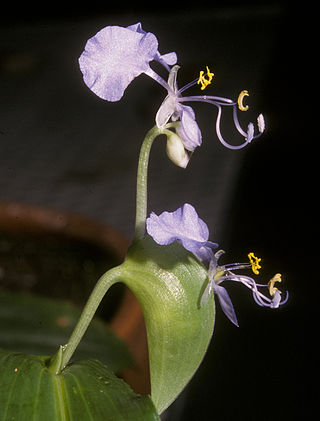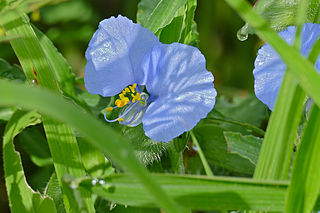
Commelina is a genus of approximately 170 species commonly called dayflowers due to the short lives of their flowers. They are less often known as widow's tears. It is by far the largest genus of its family, Commelinaceae. The Swedish taxonomist Carl Linnaeus of the 18th century named the genus after the two Dutch botanists Jan Commelijn and his nephew Caspar, each representing one of the showy petals of Commelina communis.

Commelinaceae is a family of flowering plants. In less formal contexts, the group is referred to as the dayflower family or spiderwort family. It is one of five families in the order Commelinales and by far the largest of these with about 731 known species in 41 genera. Well known genera include Commelina (dayflowers) and Tradescantia (spiderworts). The family is diverse in both the Old World tropics and the New World tropics, with some genera present in both. The variation in morphology, especially that of the flower and inflorescence, is considered to be exceptionally high amongst the angiosperms.

Commelina tuberosa is an herbaceous perennial plant in the dayflower family which is native to Mexico but grown worldwide as an ornamental plant. It is characterized by its purple-splotched spathes with free margins, its bright blue petals of equal size, its tuberous roots, and its four to ten flowered lower cymes. In the wild, it is encountered in moist fields, open forests, or pine-oak forests. The species is sometimes considered to include the species Commelina coelestis, Commelina dianthifolia, and Commelina elliptica, such as in the Flora Mesoamericana. When these are treated as separate, they are often referred to as the "Commelina tuberosa complex". Horticulturally, the species are often treated as separate entities because of their differing habits and leaf shapes. In this sense, Commelina tuberosa is a low-growing plant with long narrow leaves.

Commelina communis, commonly known as the Asiatic dayflower, is an herbaceous annual plant in the dayflower family. It gets its name because the blooms last for only one day. It is native throughout much of East Asia and northern parts of Southeast Asia. In China, the plant is known as yazhicao, roughly translating to "duckfoot herb", while in Japan it is known as tsuyukusa, meaning "dew herb". It has also been introduced to parts of central and southeastern Europe and much of eastern North America, where it has spread to become a noxious weed. It is common in disturbed sites and in moist soil. The flowers emerge from summer through fall and are distinctive with two relatively large blue petals and one very small white petal.

Commelina diffusa, sometimes known as the climbing dayflower or spreading dayflower, is a pantropical herbaceous plant in the dayflower family. It has been introduced to the southeastern United States where it is most common in wet disturbed soils. There are two recognised varieties, one being the type and the other being C. diffusa var. gigas, which is native to Asia and has been introduced to Florida. It flowers from spring to fall and is most common in disturbed situations, moist places and forests. In China the plant is used medicinally as a febrifuge and a diuretic. A blue dye is also extracted from the flower for paints. In the Hawaiian Islands, it is known as "honohono grass", although it is technically not a grass. "Honohono" refers to the alternating structure of the leaves. At least one publication lists it as an edible plant in New Guinea.

Commelina benghalensis, commonly known as the Benghal dayflower, tropical spiderwort, or wandering Jew, kanshira in Bengali, is a perennial herb native to tropical Asia and Africa. It has been widely introduced to areas outside its native range, including to the neotropics, Hawaii, the West Indies and to both coasts of North America. It has a long flowering period, from spring to fall in subtropical areas, and throughout the year closer to the equator. It is often associated with disturbed soils.

Commelina cyanea, commonly known as scurvy weed, is a perennial prostrate herb of the family Commelinaceae native to moist forests and woodlands of eastern Australia, Lord Howe Island and Norfolk Island. The blue flowers appear over the warmer months and are pollinated by bees and flies.

Commelina virginica, commonly known as the Virginia dayflower, is a perennial herbaceous plant in the dayflower family. It is native to the mideastern and southeastern United States, where it is typical of wet soils. While most members of the genus have thin, fibrous roots, the Virginia dayflower is relatively unique for its genus in having a perennial rhizome. The plant was first described by Carl Linnaeus in his 1762 publication of the second edition of Species Plantarum. A phylogenetic study based on the nuclear ribosomal DNA region 5S NTS and the chloroplast region trnL-trnF, two commonly used gene regions for determining relationships, suggested that Commelina virginica is most closely related to two African species, namely Commelina capitata and Commelina congesta. However, the statistical support for this result was low. Morphologically speaking the supposedly related species do share some unique traits. C. virginica and C. capitata have red hairs at the top of their leaf sheaths, an unusual character in the genus, while C. virginica and C. congesta both have clustered inflorescences on very short stalks.

Commelina lukei is a monocotyledonous, herbaceous plant in the dayflower family from East Africa. This blue-flowered herb has been recorded in lowland areas of Kenya, Tanzania, and Madagascar, where it is found in a variety of habitats ranging from forests to grasslands to roadsides. Described in 2008, the species was previously confused with Commelina mascarenica and Commelina imberbis. Despite this misinterpretation, a third similar species, Commelina kotschyi, is actually most closely related to C. lukei. The plant's distinctive features include a scrambling habit, capsules with a rounded extension at the apex, appendaged seeds, clasping leaf bases throughout, and solely needle-like hairs along the upper side of the leaf's midrib. The species was named in honour of the botanist W. Q. R. Luke, whose collection of the plant served as the type specimen and allowed for a complete illustration and description.
Commelina kotschyi is a monocotyledonous, herbaceous plant in the dayflower family from Africa and India. This annual, blue-flowered plant is found primarily in seasonally waterlogged soils at relatively high elevations. The species has been largely confused in floras, often being misinterpreted as Commelina imberbis. C. kotschyi is most closely related to Commelina lukei, with which it does not overlap in distribution. C. kotschyi is characterised by its appendaged seeds, capsules with a bulging apex, and undulate leaves, among other features.
Commelina sphaerorrhizoma is a monocotyledonous, herbaceous plant in the dayflower family from south-central Africa. This blue-flowered herb has been recorded from western Zambia, central Angola, and the southern portion of the Democratic Republic of the Congo, although at the time of its description it was known only from 11 collections and may be more broadly distributed. It is found in a variety of habitats ranging from woodlands to grasslands to roadsides. The plant's most distinctive feature and the source of its scientific name is its moniliform rhizome composed of spherical segments that can form a bead-like chain. Other distinguishing characteristics include glaucous leaves with clasping bases, unfused and virtually hairless spathes, capsules composed of three, one-seeded locules, and very large seeds with a hairy surface.

Commelina forskaolii, sometimes known as rat's ear, is an herbaceous plant in the dayflower family native to much of Africa, Arabia, and India. It has also been introduced to Florida in the United States. It is considered a common species in most of its range. It can be easily recognized by its bright blue flowers with winged stamen filaments. The seeds are also distinctive with distinctive irregular ridges on their sides. It often forms dense mats, and can be found most commonly in sandy soils in at least somewhat sunny situations. The species is considered a weed in many areas because of its hardiness and ability to produce cleistogamous flowers.
Commelina grossa is an herbaceous plant in the dayflower family found in the East and Southern African countries of Tanzania, Malawi, and Zambia. The species is easily recognised by its mainly basal leaves which are long and linear, and its spathes, which lack hairs and are quite large. The petals are mauve-blue with the lower petal being highly reduced and the sepals fused into a cup. These features suggest it may be related to Commelina schweinfurthii and its allies, which share many of the same floral characters. The species' typical habitat is in woodland on sandy soil or soils that become seasonally waterlogged. Flowering occurs in April and June.
Commelina acutispatha is an herbaceous plant in the dayflower family found primarily in East and Central Africa, including limited distribution in the African Great Lakes country of Uganda. In addition to that country, it is known from Sierra Leone, Liberia, Ghana, Togo, Nigeria, Cameroon, Gabon, and the Democratic Republic of the Congo. It is a common species in regions of West Africa with significant forest cover, where it is often weedy. It is most common in disturbed, moist soils, in which it scrambles over other plants. The name Commelina thomasii was often used for West African plants until it was realized that Commelina acutispatha, an older name originally applied to plants from the Democratic Republic of the Congo, was the same species. The petals range in color from white to pale lilac to violet; the lower petal is about half as large as the upper paired petals. The central anther is reported to have a blue patch on the connective. It has solitary spathes borne on a peduncle covered in hook-hairs.
Commelina hockii is an herbaceous plant in the dayflower family found primarily in Central Africa, from southwestern Tanzania in the east, west through the Democratic Republic of the Congo and Zambia, and possibly extending further west to Angola. The species' distinctive features include its long, tapering spathes with unfused margins, its white flowers, and its many-flowered lower cymes. It can be found in grasslands and Brachystegia-dominated woodland. It is fairly unusual among Commelina species in having variation in the color of the antherodes, with some individuals having entirely yellow antherodes, while others contain a dark spot in the center. Also, it is one of the only Commelina species known to leave a papery residue of dried fluid inside its spathes; normally only fused-spathe species are known to produce this substance. Only one specimen from Angola resembles this species, but it has blue flowers, suggesting it may be a poorly understood and as-yet undescribed separate species. Commelina hockii is probably closely related to Commelina kituloensis, which shares a similar fruit type, the same tufted perennial habit, similar large spathes with dried fluid substance, and equally numerously flowered inflorescences. That species differs in having purplish flowers, hairy leaves, shorter spathes, and a preference for high altitude grassland.

Commelina eckloniana is an herbaceous plant in the dayflower family with a broad distribution in Central and East Africa.
Commelina polhillii is a plant species native to Tanzania, known only from the Iriniga and Mpanda Districts. It occurs in open woodlands and in disturbed sites.
Commelina zenkeri is a plant species native to tropical Africa. It is known from Uganda and Cameroon. Unconfirmed reports place it in Democratic Republic of the Congo as well. It grows on rocky hillsides in evergreen tropical forests at elevations up to 1300 m.












